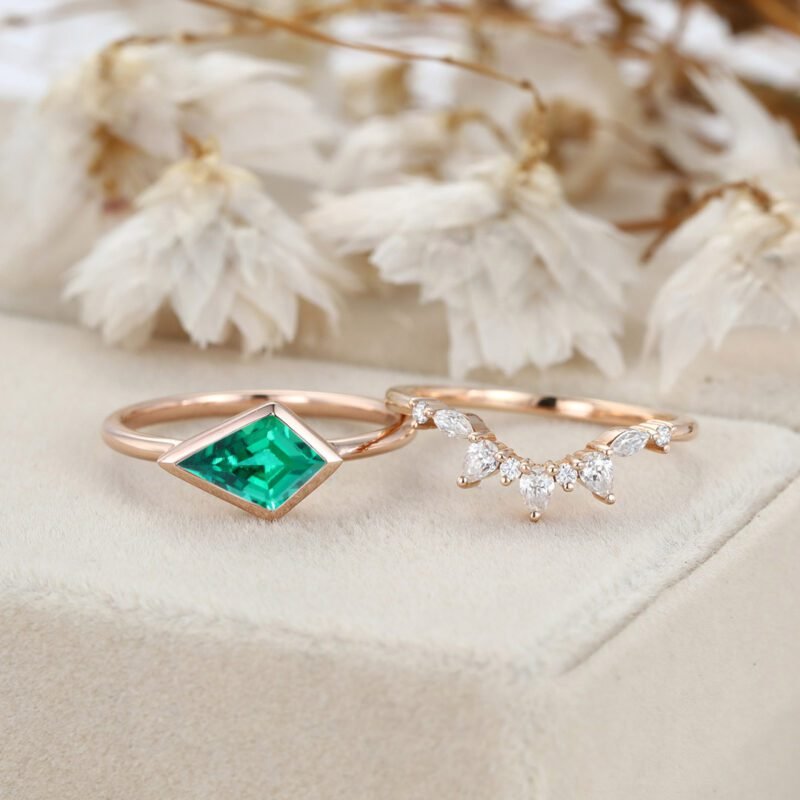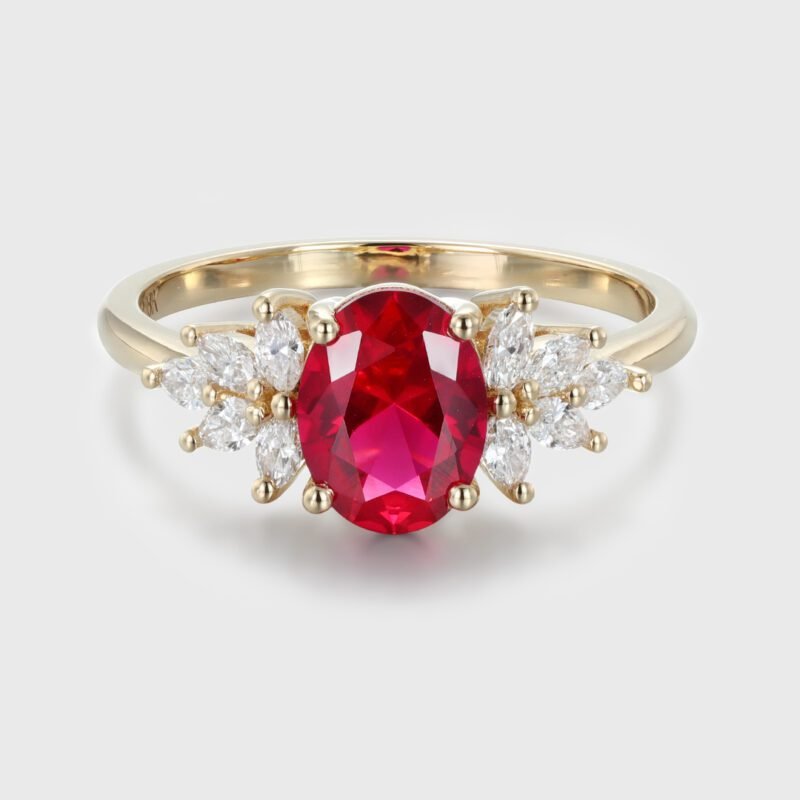Introduction: Unveiling the Essence of Gemstones
Lab-grown gemstones and natural gemstones captivate jewelry lovers worldwide, each with its own allure. Though both types radiate brilliance, their origins and features diverge significantly. Gaining insight into these differences empowers buyers to make discerning choices.
The Origins of Gemstones
Natural Gemstones: Earth’s Masterpieces
Formed over millennia beneath the earth’s surface, natural gemstones emerge from nature’s crucible of heat and pressure. Each gem bears unique imperfections and a story shaped by geological evolution, adding to its mystique and individuality.
Lab-Grown Gemstones: Science Meets Artistry
In controlled laboratories, scientists meticulously mimic the natural formation process of gemstones. Advanced technology recreates the precise environmental conditions required, yielding gems with exceptional clarity and consistency, free from natural interruptions or imperfections.

Some of the most common lab-grown gemstones include:
1. Diamonds
- Lab-grown diamonds are chemically and visually identical to natural diamonds and are produced using methods like High Pressure High Temperature (HPHT) or Chemical Vapor Deposition (CVD).
- Popular for engagement rings and fine jewelry.
2. Rubys
- Created using processes like the Verneuil method, lab-grown Rubys are as vibrant and durable as natural rubies.
- Often used in rings, pendants, and bracelets.
3. Sapphires
- Available in various colors, including blue, pink, and yellow.
- Synthetic sapphires are widely used in both fine jewelry and industrial applications like watch crystals.
4. Emeralds
- Lab-created emeralds are grown using hydrothermal or flux growth methods.
- They have fewer inclusions compared to natural emeralds, offering better clarity.
5. Alexandrite
- Known for its color-changing properties, lab-grown alexandrite mimics the rarity and beauty of natural alexandrite at a more affordable price.
6. Moissanite
- A lab-created gem that rivals diamonds in brilliance and fire.
- Popular as a diamond alternative in engagement and wedding rings.
7. Spinel
- Lab-grown spinel comes in a variety of colors, including red, pink, and blue.
- Less expensive but durable and visually stunning.
8. Quartz (Amethyst, Citrine, etc.)
- Lab-created quartz includes varieties like amethyst, citrine, and smoky quartz.
- Used in fashion jewelry and for metaphysical purposes.
9. Opals
- Lab-grown opals display vivid play-of-color similar to natural opals.
- Often used in statement jewelry pieces.
Appearance and Quality
Visual Appeal
Lab-grown and natural gemstones share a remarkable resemblance in visual appeal. Lab-created gems, however, often boast fewer flaws due to their carefully regulated production, while natural stones are characterized by inclusions that narrate their earthly origin.
Color and Clarity
Lab-grown gems typically exhibit vibrant hues and impeccable clarity, perfected under scientific precision. Natural stones, with their occasional blemishes and muted tones, carry an organic charm valued by traditionalists and collectors alike.
Cost Considerations
Lab-Grown: Affordable Brilliance
The streamlined production of lab-grown gemstones makes them an economical alternative. Their consistent quality and accessibility cater to buyers seeking affordability without compromising on beauty.
Natural: Rare and Priceless
The rarity of natural gemstones, coupled with their organic formation, elevates their market value. These gems, often considered luxury assets, attract collectors willing to invest in their scarcity and intrinsic allure.
Environmental Impact
Eco-Friendly Lab-Grown Gems
Lab-grown gemstones are lauded for their minimal ecological impact. The absence of mining eliminates the disruption of landscapes and ecosystems, aligning these gems with sustainable practices.
The Environmental Cost of Mining
Natural gemstone extraction, conversely, poses environmental challenges. Mining operations can degrade ecosystems and contribute to habitat destruction, raising concerns for eco-conscious buyers.

Ethical Dimensions
Conflict-Free Creations
Lab-grown gemstones bypass the ethical dilemmas tied to mining, ensuring they are free from the stigma of conflict or exploitation. Their transparent origins offer peace of mind to conscientious consumers.
The Ethical Complexities of Natural Gems
Natural gemstones can originate from regions where unethical practices are prevalent. Verifying the ethical sourcing of these gems is essential for those prioritizing responsible purchasing.
Durability and Longevity
Resilient Lab-Grown Gems
Lab-grown gemstones exhibit the same durability as their natural counterparts, making them ideal for everyday adornment and long-lasting jewelry pieces.
Timeless Natural Gems
Natural gemstones have stood as symbols of enduring beauty for centuries. Their legacy and heritage continue to resonate with admirers of timeless elegance.
Durability and Longevity
Strength of Lab-Grown Gems Lab-grown gemstones share the same durability as natural ones. They are ideal for daily wear and long-term use in various types of jewelry.
Natural Gems Stand the Test of Time Natural gemstones have been cherished for centuries and remain timeless. Their enduring appeal makes them a symbol of lasting beauty.
Making the Right Choice
Consider Your Priorities Your choice between lab-grown and natural gemstones depends on your preferences, values, and budget. If you prioritize sustainability and affordability, lab-grown gems are an excellent option. For uniqueness and rarity, natural gemstones may be the better choice.
Understanding Certification When purchasing either type of gemstone, always look for certifications. These ensure you receive a high-quality product that meets industry standards.
Choosing the Right Gemstone
Aligning with Your Values
When deciding between lab-grown and natural gemstones, consider your values, budget, and aesthetic preferences. Lab-grown gems are an excellent choice for sustainability and affordability, while natural stones offer unparalleled rarity and charm.
Importance of Certification
Regardless of your choice, ensure that the gemstones are certified. Certification guarantees authenticity and quality, safeguarding your investment.
Conclusion: Celebrating Gemstone Beauty
Both lab-grown and natural gemstones showcase the splendor of earth and science. Whether you gravitate toward the precision of lab-grown marvels or the organic wonder of natural treasures, each gemstone tells a story of elegance and brilliance. Selecting the perfect gem reflects not only personal taste but also an appreciation of the art and science behind its creation.
-
Emerald Engagement Rings, Engagement, Gemstone Engagement Rings, Sapphire Engagement Rings, Shop All Rings, Toi Et Moi Engagement Rings
Heart-Cut Lab Sapphire & Emerald Toi Et Moi Engagement Ring in 14K Rose Gold – Elegant Twist Birthstone Promise Ring for Women, Anniversary Gift
$710.00Original price was: $710.00.$660.00Current price is: $660.00. -
East West Bezel Set Kite Cut Lab-Grown Emerald Engagement Ring Set Rose Gold
$1,210.00Original price was: $1,210.00.$910.00Current price is: $910.00. -
2 Carat Emerald Cut Emerald and Diamond Three Stone Engagement Ring In 14k Rose Gold
$780.00Original price was: $780.00.$660.00Current price is: $660.00. -
1 Carat Princess Cut Emerald and Diamond Engagement Ring Set Vintage 14K Rose Gold Ring
$1,235.00Original price was: $1,235.00.$938.00Current price is: $938.00.














